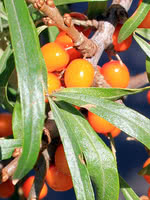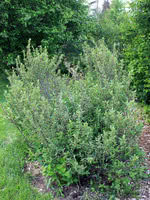Mon-Fri 9am - 5pm Mountain time
Sea Buckthorn (Seaberry) vs Canadian Buffaloberry
Hippophae rhamnoides l.
Shepherdia canadensis
Sea Buckthorn, aka Seaberry, is a nitrogen fixing shrub that produces attractive berries high in vitamin C.
While we can't confirm claims that the berries are effective in treating various ailments, many people believe consuming the berries helps with arthritis, infections, and asthma, among other things.
Sea Buckthorn plants have attractive pale silvery-green leaves, dense branches, and large thorns, people like to grow in ornamental hedges or as a first row in a shelterbelt.
Note: these plants typically reach maturity and make their sex easily known (females producing fruit) in their 3rd or 4th year of growth. Our seedlings are too young to identify their sex.
Canadian Buffalo Berry is a native deciduous shrub found throughout North America. This hardy, medium-sized shrub will tolerate poor soil conditions and produces attractive, edible–though very bitter–red fruit.
Sea Buckthorn (Seaberry) Quick Facts
Canadian Buffaloberry Quick Facts
In row spacing: 0.9 - 1.2 m (3 - 4 ft)

